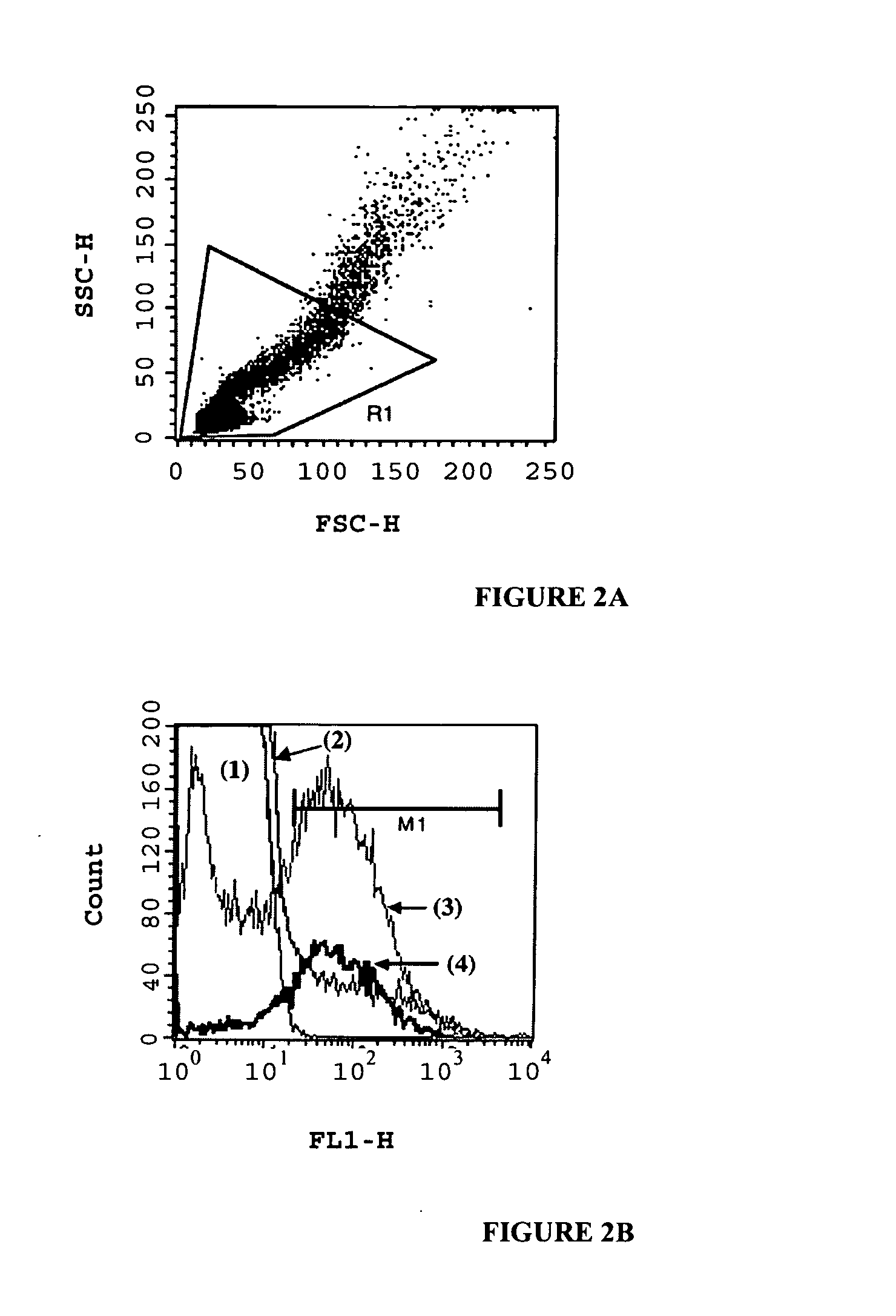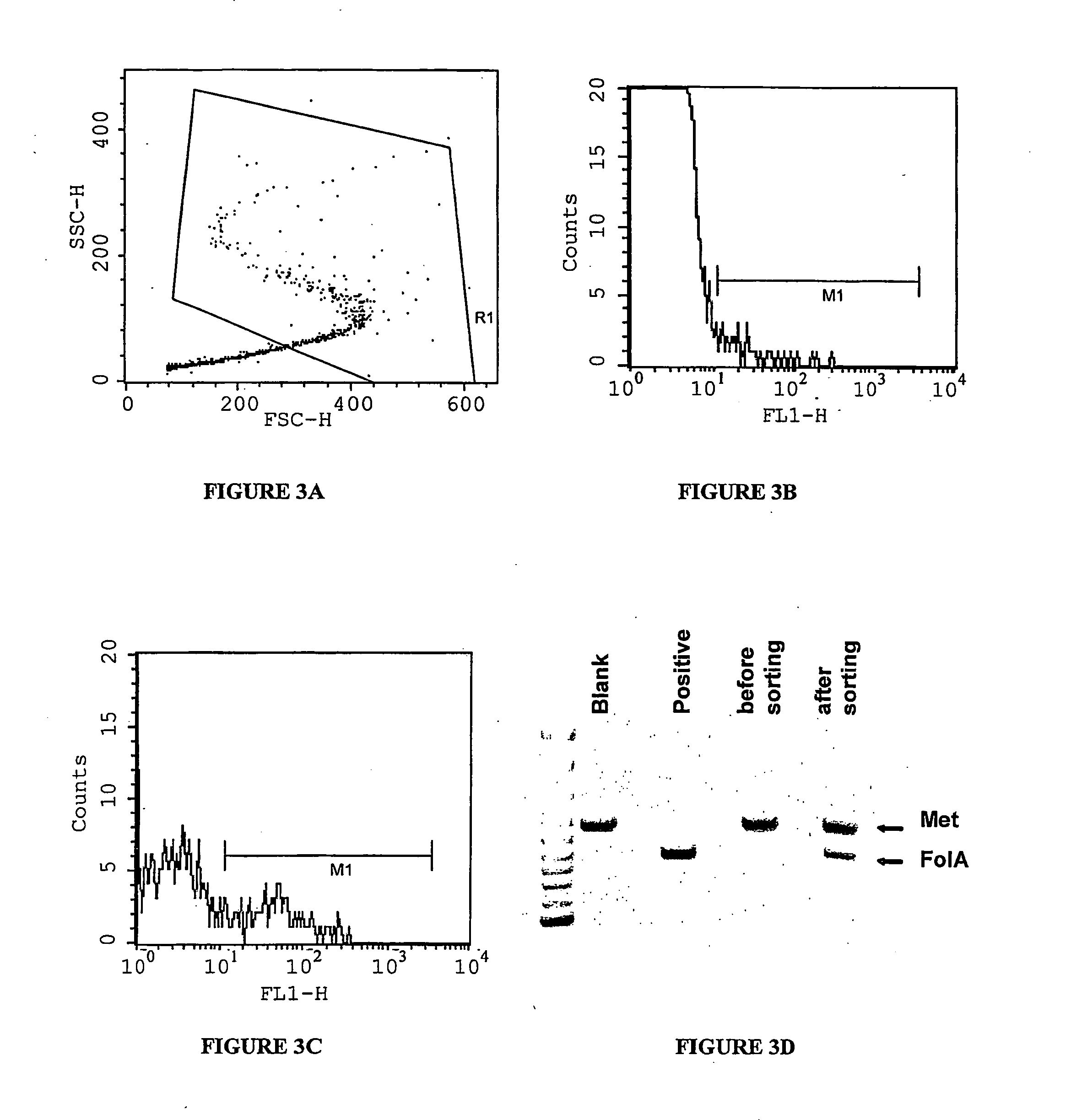Compositions and methods for in vitro sorting of molecular and cellular libraries
a molecular and cellular library technology, applied in the field of libraries of molecules or cells, can solve the problems of not allowing direct selection of activities, limited scope of the above system, and the library size allowed by phage display technology, and achieves stable emulsions, wide potential, and high throughput.
- Summary
- Abstract
- Description
- Claims
- Application Information
AI Technical Summary
Benefits of technology
Problems solved by technology
Method used
Image
Examples
example 1
Preparation and Sorting of Water in Oil in Water Emulsions by FACS
Preparation of W / O / W Double Emulsions
[0269] The primary water phase (80 μl of 4.8% Tween-80 in phosphate buffered saline (PBS; 50 mM sodium phosphate, 100 mM NaCl, pH 7.5)) was added to 0.8 ml of ice-cold oil mix (4.5% Span-80 in light mineral oil). The two phases were homogenized on ice in a 2 ml round-bottom cryotube (Corning) for 5 min at 9500 RPM (using IKA (Germany) T-25 homogenizer) to give the w / o emulsion. To this w / o emulsion, 0.8 ml of the second water phase was added (2% Tween-20 in PBS) and the mixture was homogenized for 2 min at 8000 RPM to give the double w / o / w emulsion.
Sorting of W / O / W Emulsions by FACS
[0270] W / o / w emulsions were diluted in excess of PBS and run in a Vantage SE flow cytometer (Becton-Dickinson) using PBS as sheath fluid, at ˜8000 events per second, with 70 μm nozzle, exciting with a 488 nm argon ion laser (coherent Innova 70) and measuring emissions passing a 530±20 nm bandpass f...
example 2
Enrichment of LacZ Genes from a Pool of Mutant LacZ Genes Based on Beta-Galactosidase Activity Inside the Aqueous Droplets of a Water-In-Oil-In-Water (W / O / W) Emulsion
[0284] This example shows how single genes encoding enzymes with a desired activity can be selected from a pool of genes using double emulsion selection.
[0285] It is demonstrated that lacZ genes encoding for active beta-galactosidase enzyme can be selected from a pool of mutant lacZ genes by expressing single genes in the aqueous compartments of a water-in-oil emulsion in the presence of the fluorogenic substrate, fluorescein digalactoside (FDG). When the gene present in the aqueous compartment encodes for an active beta-galactosidase enzyme, FDG inside the compartment will be converted into the fluorescent product fluorescein (excitation 488 nm, emission 514 nm). Conversion of the w / o emulsion into a w / o / w emulsion allows sorting of fluorescent droplets using a flow cytometer. After a single round of selection, LacZ ...
example 3
Mutants with Improved Beta-Galactosidase Activity can be Selected from a Random Mutagenesis Library of Evolved Beta-Galactosidase (Ebg) Using Double Emulsion Selection
[0300] Evolved β-galactosidase (Ebg) from Escherichia coli has been used since 1974 as an in vivo model system to dynamically study the evolutionary processes which have led to catalytic efficiency and substrate specificity in enzymes (Hall B. G, Malik H. S. Mol Biol Evol. 15(8):1055-61, 1998; Hall B. G. FEMS Microbiol Lett. 174(1):1-8, 1999; Hall B. G. Genetica. 118(2-3):143-56, 2003).
[0301] Wild-type Ebg from E. coli is an α4β4 heterooctamer, in which ebgA encodes the beta subunit and ebgC encodes the β subunit Ebg is a virtually inactive β-galactosidase. However, it is known from in vivo studies that in E. coli strains which carry a deletion of the lacZ gene, and which cannot utilize lactose or other β-galactoside sugars as carbon or energy sources because they do not synthesize the LacZ beta-galactosidase, ebgAC ...
PUM
| Property | Measurement | Unit |
|---|---|---|
| molecular weight | aaaaa | aaaaa |
| molecular weight | aaaaa | aaaaa |
| molecular weight | aaaaa | aaaaa |
Abstract
Description
Claims
Application Information
 Login to View More
Login to View More - R&D
- Intellectual Property
- Life Sciences
- Materials
- Tech Scout
- Unparalleled Data Quality
- Higher Quality Content
- 60% Fewer Hallucinations
Browse by: Latest US Patents, China's latest patents, Technical Efficacy Thesaurus, Application Domain, Technology Topic, Popular Technical Reports.
© 2025 PatSnap. All rights reserved.Legal|Privacy policy|Modern Slavery Act Transparency Statement|Sitemap|About US| Contact US: help@patsnap.com



